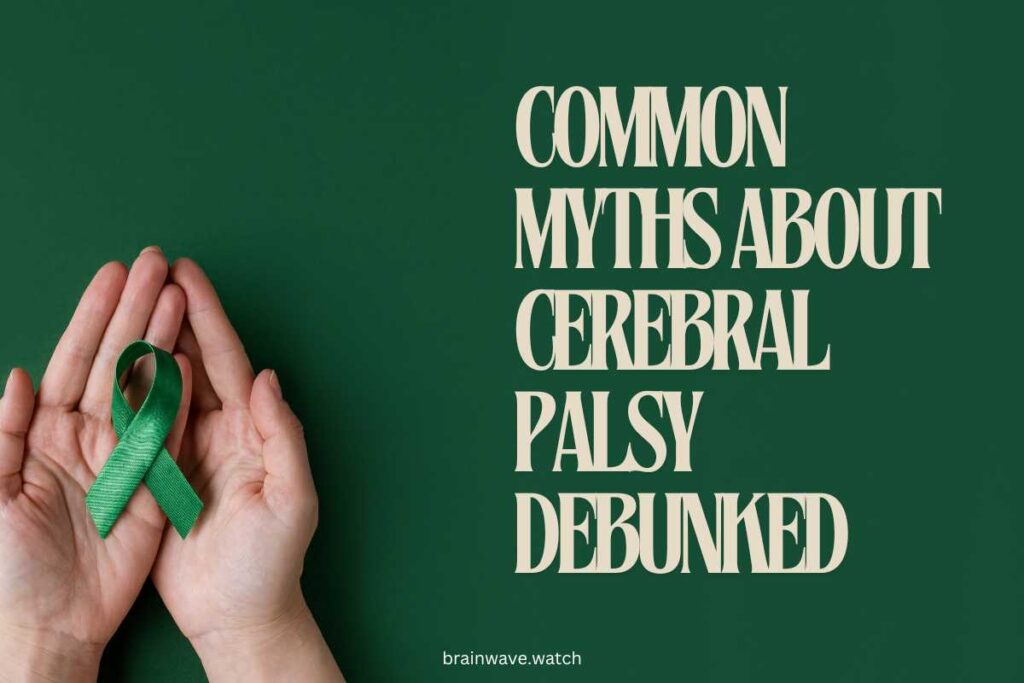Cerebral palsy (CP) is the most common motor disability in childhood. Yet, many may not fully understand it. In recognition of World Cerebral Palsy Day (October 6th) and beyond, let’s raise awareness for CP and celebrate the remarkable strength and potential of individuals living with it. This article dives into the realities of CP, dismantles misconceptions, and explores ways to create a more inclusive world where everyone can reach their full potential.
What is cerebral palsy?

Cerebral palsy (CP) is a group of disorders that affect movement and muscle tone or posture. It’s caused by damage to the developing brain, most often before birth.
Signs and symptoms can vary greatly. Some people with cerebral palsy may have difficulty walking and sitting. Others may have trouble grasping objects. Sometimes the symptoms are hardly noticeable.
Several types of CP affect different parts of the brain:
- Spastic CP is the most common type of CP, where muscles are stiff and movements can be awkward. There are three subtypes:
- Spastic hemiplegia affects one side of the body
- Spastic diplegia affects the legs more than the arms
- Spastic quadriplegia affects all four limbs, the trunk, and the face
- Dyskinetic CP causes uncontrolled, slow, writhing movements
- Ataxic CP affects balance and coordination
- Mixed CP is a combination of the other types
The early damage to the brain disrupts normal development and maturation of the motor pathways. This can happen before, during, or shortly after birth due to infections, lack of oxygen, or trauma. Cerebral palsy itself is not progressive, but the symptoms can change over time as a child grows.
Signs and symptoms
Cerebral palsy can manifest in different ways, but there are some common signs and symptoms. These often become noticeable in early childhood.
One of the main symptoms is muscle weakness and stiffness, particularly in the trunk, arms, and legs. This can affect a child’s motor development, making it difficult for them to roll over, sit, crawl, or walk. Muscle tightness may also lead to abnormal posture.
Another sign is delayed in reaching developmental milestones like holding up their head, sitting, standing, and walking. A baby with cerebral palsy may be significantly late in attaining these motor skills compared to other children their age.
Many children with CP have trouble with movement and coordination. Their movements may appear awkward and they may have shaky hands or walk on their toes. They can have trouble swallowing food and controlling their bladder and bowel.
Fine motor skills like grasping objects and writing can also be impaired. Some children exhibit involuntary movements like flailing arms or legs. They may have difficulty coordinating the muscles needed for speech, a condition known as dysarthria.
The symptoms of cerebral palsy can range from mild to severe, depending on which parts of the brain are affected and to what extent. Early detection is key to managing symptoms and improving quality of life.
Diagnosis
Diagnosing cerebral palsy usually involves multiple steps and medical professionals. There is no single test for cerebral palsy. Instead, doctors rely on the child’s medical history, a physical exam, and diagnostic tests to make a diagnosis.
Doctors will ask about any health problems during the mother’s pregnancy or the child’s delivery, as well as whether the child has reached normal developmental milestones for their age. This information provides important clues about potential risk factors.
During a physical exam, a doctor will check a child’s posture, coordination, muscle tone, reflexes, and other signs of developmental progress. This can help determine if delays or abnormalities are present.
A variety of tests may be ordered to rule out other possible conditions and get a clearer picture of the diagnosis. Common tests include:
- Brain imaging tests like MRI or CT scan – These provide views of the brain to look for any structural abnormalities.
- Blood tests – These check for genetic conditions or infections.
- Hearing and vision tests – Sensory deficits could impact development.
- Electroencephalogram (EEG) – This records electrical activity in the brain and can detect seizures.
Putting together all the pieces of evidence from the medical history, exam, and testing helps doctors definitively diagnose cerebral palsy. Ongoing evaluations will also monitor the child’s specific symptoms and needs.
Treatments
There are several treatments available to help manage the symptoms of cerebral palsy and improve quality of life.
Physical and occupational therapy are important components of treatment for cerebral palsy. These therapies help improve motor function, prevent contractures, and maintain or increase range of motion and mobility. Some common techniques include:
- Stretching and range of motion exercises
- Strength training
- Gait training and mobility aids like walkers or braces
- Fine motor skills training
- Sensory integration therapy
- Hydrotherapy or swimming therapy
Regular therapy can help maximize independence in daily activities. Goals are tailored to the individual’s needs and abilities.
Medications may be prescribed to help control symptoms associated with CP like muscle spasticity, drooling, pain, and seizures. Common medications include:
- Muscle relaxants like baclofen or benzodiazepines to reduce spasticity
- Anticholinergic agents like glycopyrrolate reduce drooling
- Analgesics to relieve pain
- Anticonvulsants to control seizures
Medications need to be closely monitored by a doctor for side effects and efficacy.
Surgery may be considered in some cases to improve mobility, reduce spasticity, and correct bone and joint deformities. Some surgical procedures used for CP include:
- Orthopedic surgery to lengthen muscles or cut overactive nerve roots
- Selective dorsal rhizotomy to reduce spasticity
- Spine stabilization to correct scoliosis
- Hip, knee, or ankle surgeries to improve joint alignment
The risks and benefits of surgery are carefully evaluated on an individual basis. Ongoing therapy is usually needed after surgery as well. Close follow-up care is essential for optimal outcomes.
Living with Cerebral Palsy
Cerebral palsy affects people in different ways, but most individuals with CP require additional support and adaptive equipment to participate in daily activities.
Special Equipment Needs
Many people with cerebral palsy use assistive devices and mobility equipment including walkers, wheelchairs, braces, communication tools, and more. These tools allow people with CP to move around, communicate, and complete tasks more independently. Some common assistive devices used are:
- Wheelchairs and scooters for mobility
- Walkers, canes, crutches, and orthotics like braces or casts to assist walking
- Standing frames to help bear weight and improve bone density
- Communication devices like tablets with speech software if unable to speak
- Special utensils like grippers, cups, and straws that are easier to hold
- Shower chairs, grab bars, lifts, and other tools for bathing and hygiene
Increased Support Needs
Depending on the severity, people with CP often require additional care and support from caregivers, aides, nurses, or family members. This can include:
- Physical assistance with getting dressed, bathing, grooming, and using the bathroom
- Help with preparing meals, eating, taking medication
- Transportation for appointments, errands, school, or work
- Emotional support in coping with challenges or pain
- Financial assistance for medical bills, equipment, home modifications
Adapting Activities
CP affects motor function, so many common activities like sports, hobbies, or even household chores may need to be adapted. Some examples include:
- Using adaptive sports equipment like custom wheelchairs, walkers, or grips
- Switching to seated activities like wheelchair sports, tabletop games, or art
- Using computers, voice commands, or other tools to participate in hobbies
- Modifying household tasks by doing them seated or using specialized tools
- Finding new creative outlets like painting, singing, blogging, or public speaking
With the right support, tools, and a positive attitude focused on abilities rather than disabilities, people with CP can adapt activities to participate, thrive, and enjoy their lives. The key is maintaining independence wherever possible and focusing on each person’s strengths.
Causes
Cerebral palsy can be caused by a few different factors that occur during pregnancy or birth:
- Premature birth – Babies born prematurely, before 37 weeks of pregnancy, are at a higher risk of cerebral palsy. Their brains and bodies may not be fully developed, which can lead to injury during birth.
- Lack of oxygen during birth – If an infant’s brain lacks sufficient oxygen during labor and delivery, brain damage can occur. Issues with the placenta, umbilical cord, or contractions during birth may disrupt oxygen flow.
- Infection/illness – Certain infections in the mother, like rubella or cytomegalovirus, can cause cerebral palsy in the baby. Meningitis and other serious illnesses in the infant can also damage the brain.
Cerebral palsy is estimated to affect around 1 in 345 children in the United States. This means that between 500,000 and 700,000 Americans have some form of cerebral palsy.
Cerebral palsy is more common in boys than girls. The male-to-female ratio is approximately 1.4:1. Scientists are still researching potential reasons for this disparity.
Cerebral palsy is not a progressive or degenerative condition. Many people with CP live full, healthy, and productive lives well into adulthood and old age. With the right support and accommodations, having CP does not preclude living independently, going to school, working, having relationships, and participating in the community.
Modern medicine and assistive technology have dramatically improved the outlook for people with CP. Most can expect to have a normal life expectancy. While CP is a lifelong condition, the symptoms do not necessarily get worse over time. With proactive treatments starting early in childhood, many people see significant improvements in mobility, communication skills, and independence. Ongoing physical, occupational, and speech therapy help maximize abilities throughout the lifetime.
Strong social support also plays a key role in optimizing the quality of life for those with CP. Having understanding caregivers, teachers, employers, and community members makes a big difference. Creating inclusive spaces and promoting accessibility enables full participation. While CP presents challenges, focusing on each person’s abilities and providing the right assistance allows individuals to thrive. The future continues to look brighter as awareness, support, and opportunities keep improving.
Advocacy
There are many ways to raise awareness and advocate for people with cerebral palsy and their families. Some ideas include:
Raising Awareness
- Share facts, statistics, and personal stories about cerebral palsy on social media. This helps educate others about the condition.
- Volunteer for or donate to organizations that support people with CP and their families. This expands their reach and impact.
- Talk openly about cerebral palsy and correct misconceptions people may have. Increased understanding leads to greater inclusion.
- Participate in awareness months/days like World CP Day on October 6th. Displaying solidarity helps reduce stigma.
Supporting Research
- Donate to organizations funding CP research, like the Cerebral Palsy Foundation. This helps find new treatments and a cure.
- Advocate for more government funding for CP research. More funding accelerates scientific discoveries.
- Participate in clinical trials and studies if able. Contributing data drives research forward.
Improving Access
- Support laws, policies, and programs that increase accessibility for those with disabilities. This enhances independence and inclusion.
- Advocate for insurance coverage of medical equipment, therapy services, medications, etc. Improving affordability increases access.
- Volunteer with adaptive sports programs and recreational activities. This promotes active lifestyles and social connections.
- Help make public spaces, workplaces, and technology more accessible. Removing barriers creates a more inclusive world.
Resources
Many organizations provide support, information, and ways to get involved for people living with cerebral palsy and their families.
Organizations for Support and Information
- United Cerebral Palsy – National organization dedicated to advocating for people with CP and providing resources. www.ucp.org
- Cerebral Palsy Foundation – Provides education, research funding, and support services. www.yourcpf.org
- Cerebral Palsy Alliance – Australian organization with therapy services, research, and support. www.cerebralpalsy.org.au
- Scope – UK charity for people with cerebral palsy. www.scope.org.uk
Places to Donate
- Help Hope Live – Crowdfunding for people with CP. helphopelive.org
- Cerebral Palsy Foundation – Accepts donations to fund research grants. yourcpf.org/donate
- March of Dimes – Funds CP research and programs. www.marchofdimes.org
Ways to Volunteer
- Become a peer mentor for teens/adults with CP
- Help at adaptive sports events and camps
- Volunteer at schools and therapy centers
- Participate in fundraising walks/events
- Advocate for disability rights and inclusion







